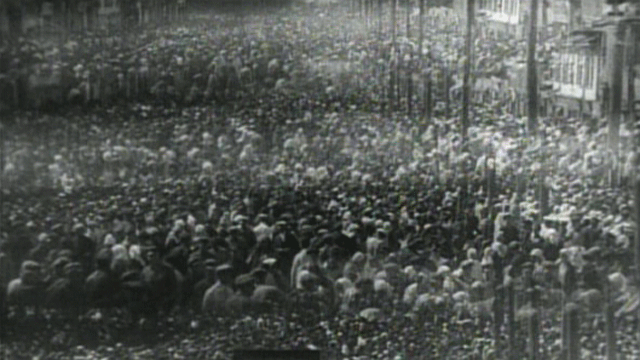Walter Ruttmann’s Berlin: Symphony of a Great City (1927) begins with a severe-looking train (watch YouTube video), purposefully crossing the German countryside toward Berlin. No wonder people are moving to cities so rapidly; Berlin is a dizzying, fast-paced, modern metropolis. Rail, hydro, and sewer lines cross the city, powering the impressive machinery of the great factories. It becomes clear that the future, according to Ruttmann, is in the modern metropolis.
However, Ruttmann does acknowledge that inequality and class differentiation trouble Berlin. Working-class citizens are compared to domesticated beasts (watch YouTube video), being herded from trains into factories, while the aristocracy enjoys feasting like lions. Indeed, Ruttmann makes several comparisons between Berliners and animals. It is a place of wild, often unbridled energy, spontaneity, and ferocious competition—a dog-eat-dog world. Furthermore, it emphasizes the Corbusian idea that “all men have the same needs,” the same physiological prerequisites for life. As such, the machinery featured so prominently by Ruttmann in Berlin represents the ability for the industrial revolution to satisfy the needs of all people; standardization is a powerful democratizing force.
The importance of industry and standardization to democracy is obvious in Communism; hence, Soviet director Dziga Vertov embraces Modernism in 1929 film Man With A Movie Camera. Some scenes—particularly the ones of industrial machinery—are remarkably similar to those in Berlin, but while Ruttmann tells a story about life in Berlin, Vertov eliminates subjective interpretation from his documentary, emphasizing the ‘experimental’ nature of his film and its lack of inter titles, script, or theatre (watch YouTube video). Vertov wanted to establish "an absolute and universal cinematographic language completely free of theatrical or literarly language", and as such, traditional narrative devices are replaced by self-reflexivity and cinematic manipulation. Berlin is a commentary, but Vertov intends Man With A Movie Camera to be considered 'gospel'—appropriate for a Soviet Union whose national newspaper was called Pravda, or Truth. To Vertov, the camera is not a lens, but what he calls the Kino-Eye (cinema-eye). It, like Modernist ideology, is completely objective. →
